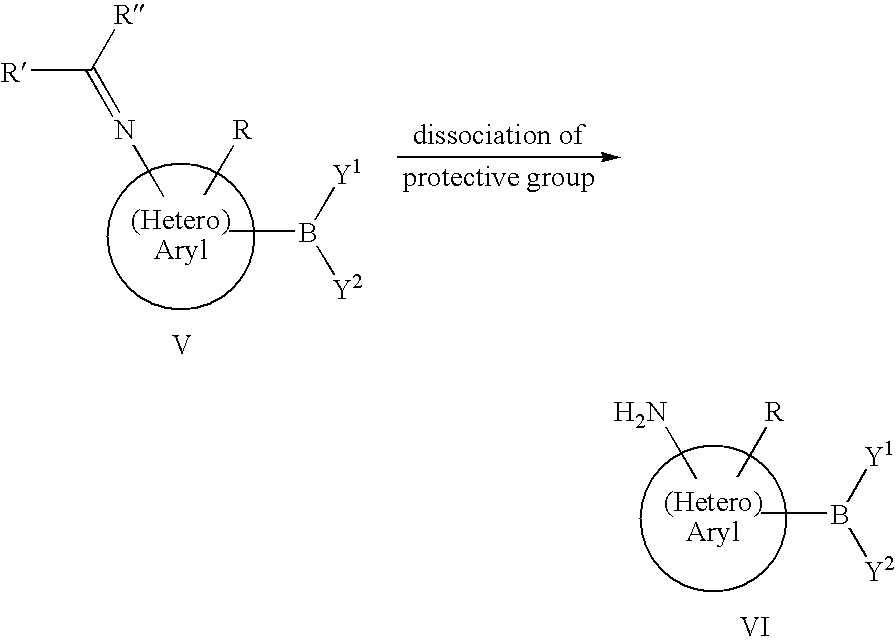Preparation of Aminoaryl and Aminoheteroaryl Boronic Acids and Derivatives Thereof
- Summary
- Abstract
- Description
- Claims
- Application Information
AI Technical Summary
Benefits of technology
Problems solved by technology
Method used
Image
Examples
example 1
3-aminophenylboronic acid pinacol ester through halogen-metal exchange using n-butyllithium at benzhydryliden-(3-bromo-phenyl)-amine
[0068]A mixture of 208.9 g (1.22 mole) 3-bromo aniline, 211.8 g (1.16 mole) benzophenone and 11.1 g (58.2 mmole) p-toluenesulfonic acid in 1000 g toluene is heated to boiling for 24 h under reflux, whereby the generated water is removed. Eventually obtained solid substance is filtered, the filtrate is freed from toluene by distillation. The residue is brought to crystallisation through slow addition of methanol in the cold. The crystals are sucked, washed with toluene and dried under vacuum. The thus prepared solid is the protected amine benzhydryliden-(3-bromo-phenyl)-amine. Yield: 313.9 g (0.933 mole, 77%)
[0069]20.0 g (59.5 mmole) benzhydryliden-(3-bromo-phenyl)-amine are dissolved in 147 g dry THF and cooled to −78° C. At this temperature 17.8 g (65.5 mmole) of 2.5 M n-butyllithium solution in hexane is slowly added. The mixture is continually stirre...
example 2
2-aminophenylboronic acid pinacol ester through halogen-metal exchange using n-butyllithium at benzhydryliden-(2-bromo-phenyl)-amine
[0073]2-bromide aniline is protected, converted and reconditioned as described in example 1 for 3-bromide aniline. Thus, 2-aminophenylboronic acid pinacol ester is obtained with 56% yield (over all steps).
example 3
[3-(4,4,5,5-tetramethyl-[1,3,2]dioxaborolan-2-yl)-phenyl]-carbamin acid-tert-butylester through halogen-metal exchange using n-butyllithium at benzhydryliden-(3-bromo-phenyl)-amine
[0074]The synthetic of 3-aminophenylboronic acid pinacol ester is carried out as described in example 1. After completion of pinacolisation and phase separation the mixture is, however, not concentrated, rather the remaining organic phase is azeotropically dried. The residue, after adding 15.6 g (71.5 mmole) of di-tert-butyl-dicarbonate (boc-anhydride) is stirred at 80° C. for 12 h. Thereafter the bulk of the solvent is removed by distillation and the mixture is cooled to −5° C. Thereby the product crystallizes in the form of colorless crystals and can be isolated by filtration. Thus, 12.5 g (39.2 mmole, 85%) [3-(4,4,5,5-tetramethyl-[1,3,2]dioxaborolan-2-yl)-phenyl]-carbamic acid tert-butylester are obtained.
[0075]Yield over all steps: 66%.
PUM
 Login to View More
Login to View More Abstract
Description
Claims
Application Information
 Login to View More
Login to View More - R&D
- Intellectual Property
- Life Sciences
- Materials
- Tech Scout
- Unparalleled Data Quality
- Higher Quality Content
- 60% Fewer Hallucinations
Browse by: Latest US Patents, China's latest patents, Technical Efficacy Thesaurus, Application Domain, Technology Topic, Popular Technical Reports.
© 2025 PatSnap. All rights reserved.Legal|Privacy policy|Modern Slavery Act Transparency Statement|Sitemap|About US| Contact US: help@patsnap.com



